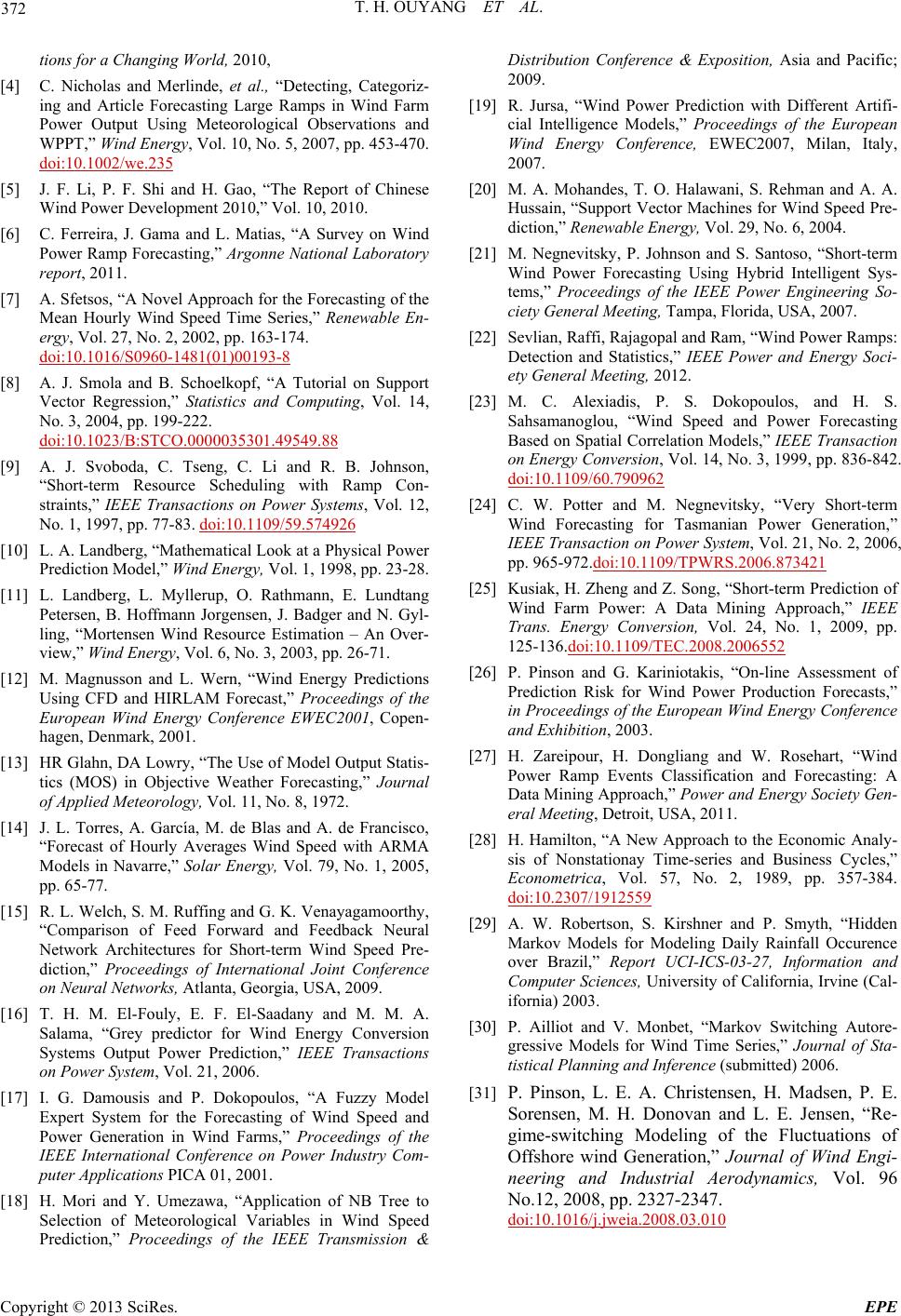
T. H. OUYANG ET AL.
Copyright © 2013 SciRes. EPE
372
tions for a Changing World, 2010,
[4] C. Nicholas and Merlinde, et al., “Detecting, Categoriz-
ing and Article Forecasting Large Ramps in Wind Farm
Power Output Using Meteorological Observations and
WPPT,” Wind Energy, Vol. 10, No. 5, 2007, pp. 453-470.
doi:10.1002/we.235
[5] J. F. Li, P. F. Shi and H. Gao, “The Report of Chinese
Wind Power Development 2010,” Vol. 10, 2010.
[6] C. Ferreira, J. Gama and L. Matias, “A Survey on Wind
Power Ramp Forecasting,” Argonne National Laboratory
report, 2011.
[7] A. Sfetsos, “A Novel Approach for the Forecasting of the
Mean Hourly Wind Speed Time Series,” Renewable En-
ergy, Vol. 27, No. 2, 2002, pp. 163-174.
doi:10.1016/S0960-1481(01)00193-8
[8] A. J. Smola and B. Schoelkopf, “A Tutorial on Support
Vector Regression,” Statistics and Computing, Vol. 14,
No. 3, 2004, pp. 199-222.
doi:10.1023/B:STCO.0000035301.49549.88
[9] A. J. Svoboda, C. Tseng, C. Li and R. B. Johnson,
“Short-term Resource Scheduling with Ramp Con-
straints,” IEEE Transactions on Power Systems, Vol. 12,
No. 1, 1997, pp. 77-83. doi:10.1109/59.574926
[10] L. A. Landberg, “Mathematical Look at a Physical Power
Prediction Model,” Wind Energy, Vol. 1, 1998, pp. 23-28.
[11] L. Landberg, L. Myllerup, O. Rathmann, E. Lundtang
Petersen, B. Hoffmann Jorgensen, J. Badger and N. Gyl-
ling, “Mortensen Wind Resource Estimation – An Over-
view,” Wind Energy, Vol. 6, No. 3, 2003, pp. 26-71.
[12] M. Magnusson and L. Wern, “Wind Energy Predictions
Using CFD and HIRLAM Forecast,” Proceedings of the
European Wind Energy Conference EWEC2001, Copen-
hagen, Denmark, 2001.
[13] HR Glahn, DA Lowry, “The Use of Model Output Statis-
tics (MOS) in Objective Weather Forecasting,” Journal
of Applied Meteorology, Vol. 11, No. 8, 1972.
[14] J. L. Torres, A. García, M. de Blas and A. de Francisco,
“Forecast of Hourly Averages Wind Speed with ARMA
Models in Navarre,” Solar Energy, Vol. 79, No. 1, 2005,
pp. 65-77.
[15] R. L. Welch, S. M. Ruffing and G. K. Venayagamoorthy,
“Comparison of Feed Forward and Feedback Neural
Network Architectures for Short-term Wind Speed Pre-
diction,” Proceedings of International Joint Conference
on Neural Networks, Atlanta, Georgia, USA, 2009.
[16] T. H. M. El-Fouly, E. F. El-Saadany and M. M. A.
Salama, “Grey predictor for Wind Energy Conversion
Systems Output Power Prediction,” IEEE Transactions
on Power System, Vol. 21, 2006.
[17] I. G. Damousis and P. Dokopoulos, “A Fuzzy Model
Expert System for the Forecasting of Wind Speed and
Power Generation in Wind Farms,” Proceedings of the
IEEE International Conference on Power Industry Com-
puter Applications PICA 01, 2001.
[18] H. Mori and Y. Umezawa, “Application of NB Tree to
Selection of Meteorological Variables in Wind Speed
Prediction,” Proceedings of the IEEE Transmission &
Distribution Conference & Exposition, Asia and Pacific;
2009.
[19] R. Jursa, “Wind Power Prediction with Different Artifi-
cial Intelligence Models,” Proceedings of the European
Wind Energy Conference, EWEC2007, Milan, Italy,
2007.
[20] M. A. Mohandes, T. O. Halawani, S. Rehman and A. A.
Hussain, “Support Vector Machines for Wind Speed Pre-
diction,” Renewable Energy, Vol. 29, No. 6, 2004.
[21] M. Negnevitsky, P. Johnson and S. Santoso, “Short-term
Wind Power Forecasting Using Hybrid Intelligent Sys-
tems,” Proceedings of the IEEE Power Engineering So-
ciety General Meeting, Tampa, Florida, USA, 2007.
[22] Sevlian, Raffi, Rajagopal and Ram, “Wind Power Ramps:
Detection and Statistics,” IEEE Power and Energy Soci-
ety General Meeting, 2012.
[23] M. C. Alexiadis, P. S. Dokopoulos, and H. S.
Sahsamanoglou, “Wind Speed and Power Forecasting
Based on Spatial Correlation Models,” IEEE Transaction
on Energy Conversion, Vol. 14, No. 3, 1999, pp. 836-842.
doi:10.1109/60.790962
[24] C. W. Potter and M. Negnevitsky, “Very Short-term
Wind Forecasting for Tasmanian Power Generation,”
IEEE Transaction on Power System, Vol. 21, No. 2, 2006,
pp. 965-972.doi:10.1109/TPWRS.2006.873421
[25] Kusiak, H. Zheng and Z. Song, “Short-term Prediction of
Wind Farm Power: A Data Mining Approach,” IEEE
Trans. Energy Conversion, Vol. 24, No. 1, 2009, pp.
125-136.doi:10.1109/TEC.2008.2006552
[26] P. Pinson and G. Kariniotakis, “On-line Assessment of
Prediction Risk for Wind Power Production Forecasts,”
in Proceedings of the European Wind Energy Conference
and Exhibition, 2003.
[27] H. Zareipour, H. Dongliang and W. Rosehart, “Wind
Power Ramp Events Classification and Forecasting: A
Data Mining Approach,” Power and Energy Society Gen-
eral Meeting, Detroit, USA, 2011.
[28] H. Hamilton, “A New Approach to the Economic Analy-
sis of Nonstationay Time-series and Business Cycles,”
Econometrica, Vol. 57, No. 2, 1989, pp. 357-384.
doi:10.2307/1912559
[29] A. W. Robertson, S. Kirshner and P. Smyth, “Hidden
Markov Models for Modeling Daily Rainfall Occurence
over Brazil,” Report UCI-ICS-03-27, Information and
Computer Sciences, University of California, Irvine (Cal-
ifornia) 2003.
[30] P. Ailliot and V. Monbet, “Markov Switching Autore-
gressive Models for Wind Time Series,” Journal of Sta-
tistical Planning and Inference (submitted) 2006.
[31] P. Pinson, L. E. A. Christensen, H. Madsen, P. E.
Sorensen, M. H. Donovan and L. E. Jensen, “Re-
gime-switching Modeling of the Fluctuations of
Offshore wind Generation,” Journal of Wind Engi-
neering and Industrial Aerodynamics, Vol. 96
No.12, 2008, pp. 2327-2347.
doi:10.1016/j.jweia.2008.03.010